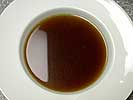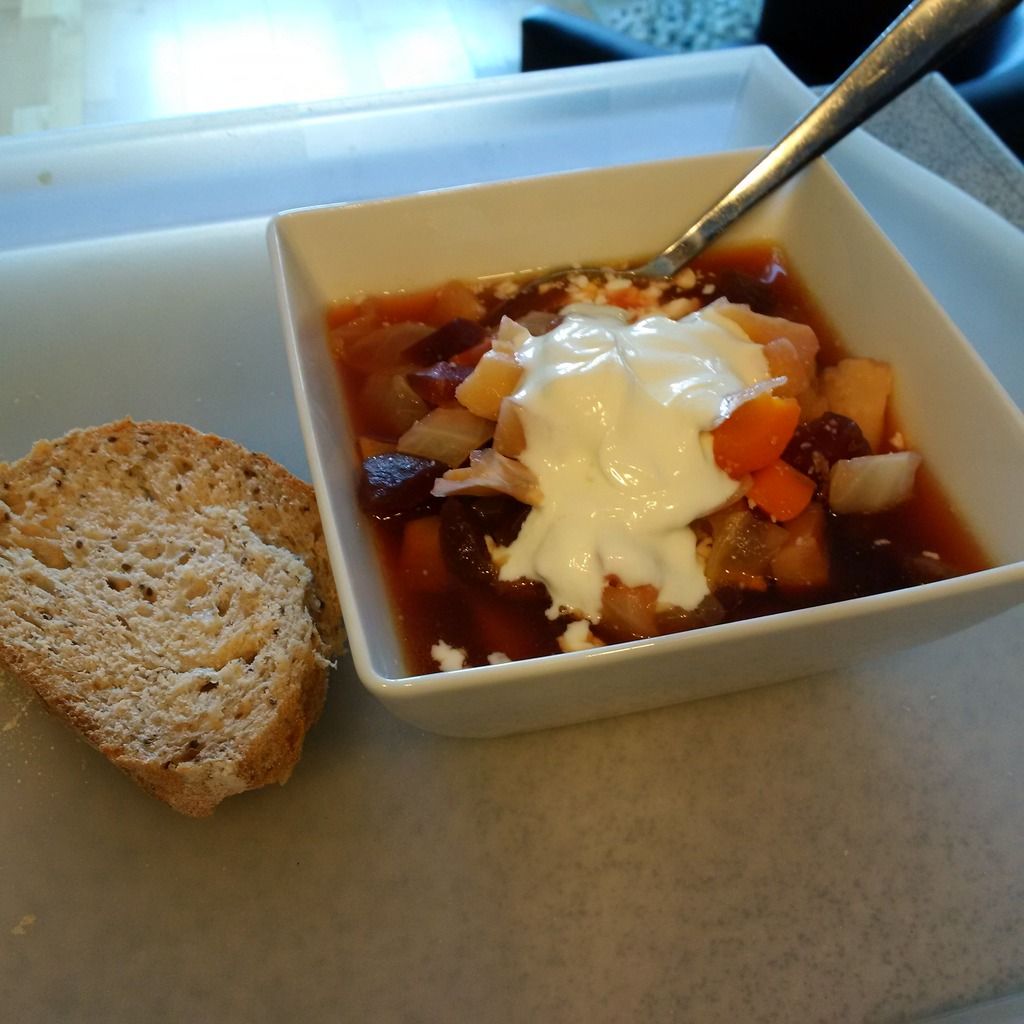Jedan od apsolutno najvećih složenaca. U ovoj varijanti dolazi s pričom, receptom i slikama.

As ubiquitous as pot-au-feu once was on the French dinner table, it may rapidly be turning into a gastronomic curiosity. Once the common evening repas of the French middle class, today a meal of pot-au-feu is a novelty. In this era of take-out food and frozen meals, preparing a dinner that requires a substantial portion of the day to cook seems anachronistic. Once ideally suited to cooking on the residual heat of the iron stove still hot from preparation of the midday meal, pot-au-feu requires too much attention for modern lives in modern times.
The concept of pot-au-feu, boiled meat and vegetables, seems simple; so simple that you could almost expect the dish to have been around as long as people have been cooking over an open fire in iron pots. By the time of the middle ages, the iron pot was truly a cauldron. “The cauldron, probably was the original stockpot, or pot-au-feu, providing an ever-changing broth enriched daily with whatever happened to be available, and very rarely cleared out except in preparation for the meatless weeks of lent.”1 The 18th century cook, according to Wheaton, started her day by mettre le pot au feu, putting the big stockpot on the fire.2
However, it seems that the earliest recipes for pot-au-feu were not published until the first half of the 19th century. According to Willan, pot-au-feu evolved from an earlier dish called pot pourri, a popular dish of the 17th and 18th centuries.3 The recipe for pot pourri that she provides as an example, one published by Menon in 1748, does have some similarities to a 19th-century pot-au-feu but it is more complicated to prepare and uses many more ingredients. (This may be because Menon was cooking for members of the French court and not the bourgeoisie.)
Another dish that may be a precursor is hochepot. La Varenne’s example of this dish starts similar to a classic pot-au-feu, but uses more exotic vegetables such as artichokes, asparagus, and mushrooms instead of the more commonplace onions, carrots, and leeks of a 19th-century pot-au-feu.4 It also uses more herbs and spices—the modern dish uses next to none. Earlier versions of this recipe can also be found in works by Massialot5 (mid 17th century) and Taillevent6 (late 13th, early 14th century).
The earliest recipes written in French that I found entitled pot-au-feu are by Carême.7 Carême provides a multi-page introduction to his two recipes—a practice that became a tradition for many of the cookbooks that followed over the next century or so. The introduction covers many aspects of the dish from the debate as to whether the resulting broth or the resulting meat, called bouilli, is more important; to how the dish is suitable for invalids; and to how all social classes could partake in the dish. Carême implied that the dish originated about the time of the revolution in 1789, a fact reiterated by Toussaint-Samat 150 years later.8
Surprisingly, a slightly earlier recipe for pot-au-feu was published in English “by an English physician, many years resident on the continent.”9 Besides providing separate recipes for the beef and the broth, much of the book’s introduction is devoted to pot-au-feu and its relationship to the French diet. Two paragraphs in particular are quite telling:
As to the economy of French cookery, it may, at first, strike the English reader that it must be much more expensive than the English culinary system owing to the constantly required supply of stock and gravy. This is, however, a mistake, for the “Premier Bouillon” or stock is nothing more than the remains of what the French commonly term the “Pot au feu;” i.e. beef and vegetable soup, which is, in fact, one of their most economical dishes, the bouilli, or beef boiled in the soup, being, in almost every French dinner, served at table after the soup, garnished with the vegetables that have been cooked with it. Thus the pot au feu answers three purposes: 1st, as a soup; 2dly, as a dish of bouilli and vegetables; and 3dly, for a reserve of stock.
Since, however, by stewing the beef a sufficient time to render the stock strong enough for kitchen use, the meat becomes too dry and insipid for a table bouilli applicable to the English palate, it is recommended to families to serve the pot au feu when the meat is properly done for the table, and to re-stew for stock what is left from the dinner in the remaining broth, adding any trimmings of meat or bones that may be in the house, and thus enriching the stock, without further expense.
The discussion as to whether to cook the pot-au-feu so the meat is best done or so the broth is best cooked is repeated in many of the books published over the next 180 years. I won’t attempt to provide a definitive answer in this discussion, but my experience with the meat and vegetables that I use is that when the meat is done, the broth is already quite tasty and not in need of any further cooking.
The physician-cum-cook alludes to another common fact in French culinary writing: pot-au-feu may refer just to the broth and not the whole dish. It is not uncommon for a French recipe to call for the leftover broth from pot-au-feu as an ingredient in a totally separate dish. Carême points out that by cooking the pot-au-feu slowly, “la ménagère a obtenu un bouillon savoureux et nutritive, et un bouilli tender et de bon goût,”—the [family] cook can obtain a tasty and nutritional soup and a piece of boiled beef that is tender and tasty.
The time period when pot-au-feu begins to appear in cookery books coincides with the rise of the French middle class. The middle class had already played an important role in the revolution, but their influence and power would continue to build during the 19th century. The middle class was also changing the design of their kitchens. Instead of cooking in front of a fireplace, the household cook would now be using a wood, charcoal, or coal-burning stove. Later the source of energy would be gas, oil, or kerosene, and the stove would be made solely of iron or a combination of iron and masonry. In either case, it took a lot of time and fuel to heat the stove and then the stove would stay hot for quite a while after the fuel began to extinguish. Dishes like pot-au-feu were ideal for cooking on the edge of the stove using the residual heat to maintain a strong simmer for a number of hours.
Carême, and later Dubois,10 recommend cooking the pot-au-feu in an earthenware stockpot. In both cases the vegetables are kept simple: onions, carrot, leeks, turnips, and celeriac. Dubois also includes a head of cabbage, something to which many later cooks object because the cabbage gives the broth a sour taste, or so they claim. In some cases, the cabbage is cooked separately and served in the same dish as the beef. Both start with cold water, but only Dubois adds a veal shank and an old chicken to the pot for extra flavor and colors the stock with a caramelized onion.
The earliest French-language pot-au-feu recipe written specifically for the home cook may be by Gouffé.11 The entire first chapter of his book, eight pages, is devoted to the preparation of pot-au-feu:
Ici, moins que jamais, je ne reculerai devant aucun détail, même les plus minutieux, quitte à faire sourire les gens qui ne se rendent pas compte de ce qu’est le premier apprentissage de la cuisine. (Here, less than ever, shall I shrink from giving the most minute details, even at the risk of appearing prolix, to those who do not take into account the inexperience of the beginner.)12
The chapter is divided into nine sections: “stockpots,” “ingredients for a good soup,” “the meat,” “mode of preparation,” “skimming the fat,” “remarks on vegetables for pot-au-feu,” “coloring of the broth—caramel,” “preservation of the broth,” and “on prolonged cooking.” Much of what he wrote is applicable today although some details, such as starting with a three-hour supply of charcoal, are now out-of-date. Gouffé’s recipe is the basis of the pot-au-feu recipe described later in this article.
Most of the major 20th-century French cookbooks provide a recipe for pot-au-feu. Some accompany the recipe with an extensive discussion, demonstrating the importance of this dish to French culinary tradition. One notable exception is Escoffier, who provided a recipe for hochepot in his Le Guide Culinaire but no recipe for pot-au-feu.13 Madame E. Saint-Ange led off her section on soups with a discussion of pot-au-feu and provided a recipe for one made of sheep as well as the traditional beef.14 Montagné said that a pot-au-feu is prepared the same as a petite marmite and served with various garnishes such as pickles, coarse salt, mustard, bread, rice, or pasta.15 Curnonsky served his with toasted croutons topped with cheddar cheese.16 Oliver pretty much ignored pot-au-feu in the French-language version of La Cuisine,17 but gave it the classic presentation in the English-language version.18 Moving into the 21st century, Michelin three-star chef Guy Martin presents three pot-au-feu recipes: one traditional; one for holidays made from sheep, veal, pork, crayfish, and a stuffed chicken; and one made from rabbit and salt pork.19
To make a pot-au-feu in your own kitchen you’ll need a large stockpot with a heavy bottom to evenly distribute the heat. Gouffé recommended tinned copper or tinned iron in 1867; he claimed earthenware and cast iron were too difficult to clean sufficiently. Today, stainless steel-lined aluminum or copper, cast aluminum, or anodized aluminum would be fine to use and are certainly more available. The old-style earthenware marmite that was recommended by many of the great chefs is no longer readily available, but a large Chinese “sand” pot would work fine in its place. A large, modern cast iron pot, with or without an enamel lining, would also work for pot-au-feu.
Besides the stockpot, you’ll need a heat source that can be regulated to very low levels. With electricity this should be no problem. On some gas stoves, a heat deflector may be required.
Other required equipment includes a large spoon for skimming the surface of the liquid, a large slotted spoon for removing meat and vegetables from the pot, a strainer for straining the liquid, and a towel or piece of unbleached muslin for lining the strainer. Depending on the cut of meat used, a piece of string may be required. Of course, the usual assortment of knives, bowls, and measuring devices found around the kitchen will come into use.
The cut of beef chosen for pot-au-feu needs to be one that benefits from long cooking over low heat. This would include the gîte à la noix (leg), the culotte (rump), the paleron (shoulder), and the plat de côtes (ribs). Large pieces should be boned and tied with string into a single piece. When the meat is boned-out, the bones should be sawed into 5-cm long pieces and added to the pot long with the meat. The ribs, sold in the United States as short ribs and France as plat de côtes, usually cut into 5-cm thick strips, can just be further cut into large pieces with one rib per piece. There should be, by weight, about one part bones for each five parts meat.
The example shown in this article uses beef exclusively, but I have been served pot-au-feu in France made from all different types of red meat. If a chicken is added to the pot, this should be added in the beginning, and removed when the meat is cooked. Some people add a large sausage to the pot, but this will leach fat into the broth. If the sausage is cooked separately, it can still be served with the meat.
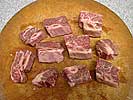

To produce about four servings, about one kilogram of meat and bones is required. For the vegetables you’ll need about 200 grams each of carrots, round onions, leeks, and turnips. Optionally, about 100 grams each of parsnips and celeriac can also be used. The carrots should be peeled and cut to about a 4-cm length. If they are very thick, they can be split lengthwise. The onions should just be peeled and the loose parts of the roots trimmed. The leeks should be cleaned, and the loose parts of the roots should be trimmed along with the thick green leaves. The turnips should be peeled and cut into 1-cm thick pieces. The parsnips, if used, should be cut to match the carrot pieces. The celeriac, if used, should be cut to match the turnip pieces.
The only seasonings required for the pot-au-feu are salt and a clove or two. Caramel coloring, if available, can be used to enrich the appearance of the final broth.
To start the pot-au-feu, place the meat and bones in the stockpot along with 4 liters of cold water and 20 grams of coarse salt. (Gouffé called for filtering the water, but, hopefully, your water is better than what was available in Paris in the middle of the 19th century.) Place the pot over the heat source and slowly bring it to a boil. When the liquid starts boil, add 100 milliliters of cold water and carefully skim the scum and fat that are floating on the surface. This process of adding cold water when the liquid starts to boil and skimming the surface needs to be repeated about three times until the liquid is quite clear.
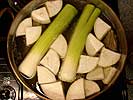
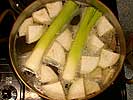
Once the liquid is clear, add the vegetables and the cloves. When the liquid comes to a simmer, lower the heat. Cook the pot-au-feu uncovered. Occasionally, remove any scum or fat that floats on the surface as the pot-au-feu cooks. Maintain the heat at a bare simmer. Use the tip of a knife to test the vegetables for tenderness, and as they become cooked, carefully remove them with a slotted spoon and set them aside. The time it takes to cook the vegetables will vary by vegetable and degree of freshness. The celeriac and parsnips will generally cook much faster than the carrots and turnips. The onions and leeks can become overcooked on the outside before the center is cooked.
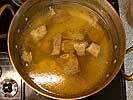
After all the vegetables are removed, continue to cook the meat until tender. Use the tines of a meat fork or the tip of a knife to judge when the meat is tender all the way through. The cooking time of the meat depends on the cut and the age of the animal. The meat should cook a total of about three to five hours. The meat should be very tender but still intact when it is cooked. It will shrink substantially during the cooking. When the meat is cooked, remove it from the stockpot with the slotted spoon and set it aside with the vegetables.
Once all the solid ingredients are removed from the broth. Skim any remaining fat from the surface with the large spoon. Wet the towel or muslin with cold water and line the bowl of the strainer. Place the strainer over a large bowl and pour the broth through the strainer. The broth should now be very clear and any pieces of meat or vegetables that were in the broth, along with the cloves, should now be captured in the strainer.
The broth from the pot-au-feu is customarily served as a separate dish before the meat and vegetables. But before serving the broth, use it to reheat the meat and vegetables. Once reheated, they can be kept warm in a covered container in a warm oven. The broth may need a second straining (but not always). Before serving the broth, taste it and, if necessary, add some salt.
To make the broth more pleasing in appearance, it can be darkened with caramel coloring. Gouffé prepared caramel coloring from sugar. Others used burnt onions for the coloring. Today, commonly available, bottled caramel coloring is the easiest to use. In a pinch, even dark, Chinese soy sauce works.
After the broth has been served and devoured, divide the meat and vegetables between heated servings plates. The onion and leeks will probably need to be carefully cut into individual servings. If the meat was cooked as a single piece, remove the string and carve the meat into individual portions. Serve the meat and vegetables along with some strong, Dijon-style mustard and a couple of cornichons. Any leftover broth can be chilled and saved for other purposes.
As you and your guests enjoy the pot-au-feu, give some thought to the dish’s long history and consider that if you don’t prepare it occasionally, pot-au-feu may become just an ancient memory.
Guy Martin. Toute la cuisine. Paris: Éditions du Seuil, 2003. In French. pp. 578-9, 634.

![]()


















